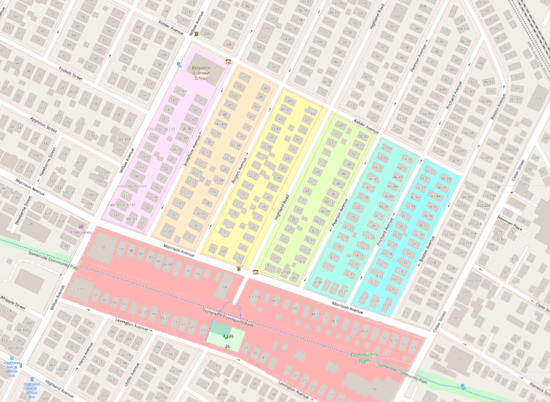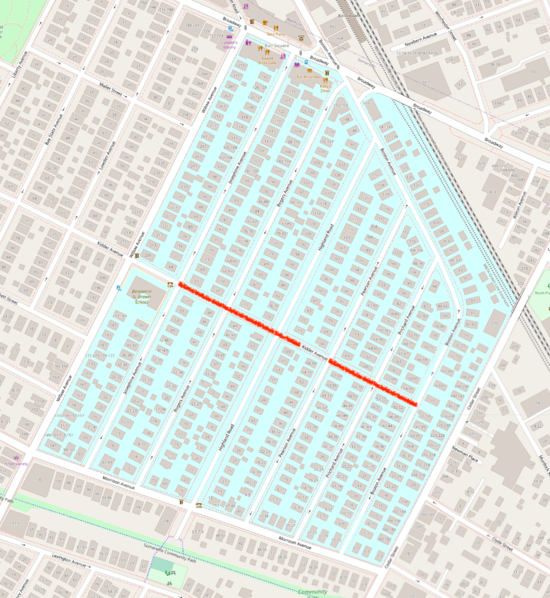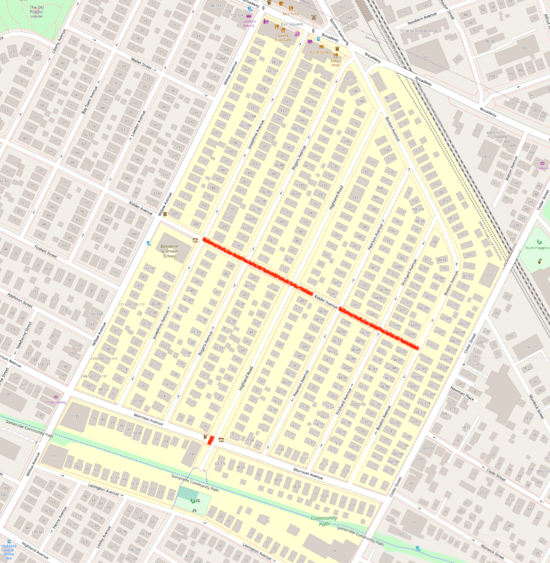Roads are the biggest limitation on mobility for our older kids, now that we’re using walkie-talkies. Anna (5y) can’t cross the street on her own, because she is not quite reliable enough at checking for cars. For her, the neighborhood is a collection of islands:
With assistance she can move between them, but otherwise she’s pretty limited.
Lily (7y) is better at crossing streets, and we let her cross specific low-traffic intersections. Here they are, in red:
You can see that this opens up the neighborhood dramatically. She can walk to school (reduces conflict when Anna is slow to get ready) and visit friends (~8 of them).
On the other hand, there are still many nearby places they really want to go and can’t, because the streets involved are too dangerous. I think the next stage will be learning how to cross at the crosswalk marked below, which opens up the community path, park, and more friends:
Right now we deal with this by just being pretty willing to help them cross that street. It’s also possible that some of this will get better with the speed humps they are planning to install in our neighborhood soon.
Comment via: facebook



At what age did you start trusting them do things like only crossing at approved intersections?
They’ve both been very trustworthy for a long time, as demonstrated in daily life. Very occasionally they, usually the younger one, will attempt to sneak something that is prohibited, but it’s very rare. I was much more concerned that they wouldn’t cross carefully enough, then that they might go farther than allowed.
But this is my experience with my particular kids, and I’m sure others have different experiences.
I think it works as long as they benefit from the rules and the overall scheme and trust you that you help them grow. If the rules get relaxed or extended as they grow (which may be fast). Some parents try to create fear of things they believe to be dangerous or that they want the kids to avoid for other reasons. If kids figure out that these things are not actually dangerous they will wonder what else they have been lied to. They may be mistaken in this so it is important to back it up. One example is: “Don’t put your finger in the door gap (esp the one at the hinges).” “Why not? Doesn’t look dangerous.” Explain levers by demonstrating with a nut or something else they know is pretty hard.
There are studies—though possibly biased ones—that show that children under the age of 10 can’t reliably (i.e.,>99%) handle the complexities of traffic:
But kids learning and impulsivity vary dramatically. Know your kids. We let our kids go to school alone by age 7 - the only crossings were a very one low-traffic zebra crossing close to the school, one very safe street crossing with traffic lights, and the street directly in front of our house.
Part of why I’m okay with them crossing the streets they do cross is that they can use the strategy of only crossing when they can’t see any moving cars. This means they don’t have to use distance / speed estimation.
And you can trust them to follow these rules even unattended.